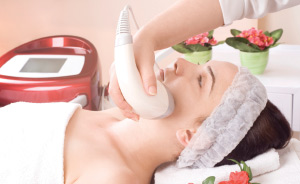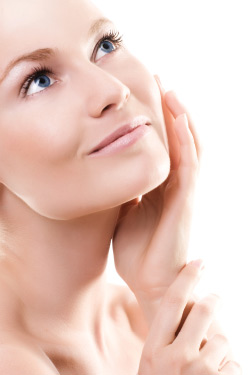As Americans of the 21st century, we sometimes beat ourselves up for our youth-obsession. More traditional cultures, we remind ourselves, honor elders. We berate ourselves for being shallow and vain as we fret over the evidence of the passing years.
But, really… even the Confucian sages of ancient China were full of praise for the “Yin” of very young women, commenting that this essential quality dissipated quickly as the woman moved out of her teens; and so on. The fact is, the only people who ever want to look older are tweens and teens, who just want to hang out in cool nightclubs and other places grown-ups go.
Young skin is defined by its health. While it is possible for young skin to be affected by disorders such as acne, eczema and rosacea, clients generally characterize young skin as healthy skin, when cell turnover is at its peak, and the skin’s naturally taut surface snaps back into place like a new pair of Spanx, thanks to robust, intact collagen and elastin.
The fact is that all of this begins to change early in life. When the results become immediately visible it varies from individual to individual. Age-related skin changes are the result of two things: Our genetic blueprint encoded in our DNA (intrinsic factors) as well as environmental wear-and-tear (extrinsic factors).
How much of it is heredity, and how much is lifestyle? Both aspects must factor into the creation of a proactive, preventive skin health program. One immediate difference is that, unless the client undergoes exhaustive DNA testing, it is impossible to know very much about the body’s intrinsic programming. Typically, we only have direct experience with one or two prior generations (mother, grandmother), but the genetic material of which we are composed dates from centuries earlier. So, our full genetic “recipe” and its inherited predispositions remain a mystery.
By contrast, we can address the here and now, specifically how we treat our skin and our bodies. We can also examine and assess our environment in order to evaluate how the external world will impact us.
Experts concur that at least 90 percent of what we interpret as visible skin aging, such as fine lines, loss of contour and hyperpigmentation, is extrinsic, specifically linked to free radical damage, with UV or photoaging heading the list. Our innate genetic material dictates how well we handle the assault of sun-damage, as well as other damage inflicted by cigarette smoke and other external stressors. For instance, a major player in the condition of every woman’s skin is estrogen. The approach of menopause, as well as other hormonal shifts, may produce visible effects in the skin, regardless of sun-exposure or other external factors.
This duality confuses many clients, especially when it comes to lifestyle choices. For this reason, early education about skin health is a key part of every skin therapist’s mission. Engaging the client in a partnership to keep skin at its healthiest by definition also will help to delay “pulling the trigger” on the cascade of processes which lead to skin aging.
The New Enemy: Sugar
This time, it is not about brownies, cupcakes or an uncontrollable sweet-tooth. One of the major recent research breakthroughs regarding skin aging has to do with sugar or glycation. We now know that collagen and elastin proteins are highly susceptible to an internal chemical reaction within the body. The same glucose that provides energy for our cells can react with proteins, such as collagen, resulting in the formation of Advanced Glycation End-products (AGEs) and free radicals (ROS). This contributes to cross-linking of protein fibers, the loss of elasticity and changes in the dermis. When AGEs form in the skin, they activate a receptor site on cells and form a complex known as Receptor Advanced Glycation End-products (RAGE) that signals cellular processes related to inflammation and subsequent disease. Coupled with this are two additional biochemical reactions in the skin:
- The formation of Reactive Oxygen Species (ROS)
- The activation of Matrix Metalloproteinase enzymes (MMPs)
ROS include oxygen ions, free radicals and peroxides. They are generally very small molecules and are highly reactive due to the presence of unpaired electrons. ROS form as a natural byproduct of the normal metabolism of oxygen. During times of environmental stress, ROS levels can increase dramatically, causing significant damage to cell structures. This is known as oxidative stress, which is the major cause of degenerative disorders including aging and disease.
Matrix degrading MMPs are enzymes that when activated, control matrix degradation in the dermis. Each MMP is specific for particular collagens or other proteins in the extracellular matrix of the dermis. Within hours of UV exposure the MMP genes are activated resulting in biosynthesis of collagenase and other MMPs. Because collagenase degrades collagen (and inhibits formation of new collagen), long term elevation results in disorganized and clumped collagen which is characteristic of photoaged skin. All of these biochemical reactions contribute to the cross-linking of protein fibers in the skin, which translates as skin degradation and loss of structural integrity. The visible result of this cross-linking is the clumping, thickened, “ropy” effect we often observe in aged skin, especially skin which has been subjected to sun, cigarette-smoke and other forms of oxidative stress.
These reactions, formations and visible results are linked with inflammation, which now is recognized as the enemy of overall health in virtually every physiological system. Again, simply put, inflammation is the catalyst behind what we know as the aging process, in the skin and throughout the body. The key to healthier skin which retains the resiliency of youth is to “trap” or arrest these biochemicals and quench them before they damage collagen and other tissues.
Managing These Biochemical Reactions
Our bodies are designed to fight free radical damage intrinsically. However, the fact is that modern industrial life places our defense systems on “overload.” Also, we are living longer than past generations, so our natural defensive reserves may be depleted well before our lives end. These facts require support and supplementation, including topically applied products.
Ingredients Demonstrated to fight MMPs, AGEs and ROS:
- Dipotassium glycyrrhizate (licorice)
- Genestein
- Glucosamine
- Argine/Lysine polypeptide
- Palmitoyl tripeptide-5
- Retinol, retinyl palmitate (vitamin A)
- Ascorbic acid, magnesium ascorbyl phosphate (vitamin C)
- Tocopheryl acetate (vitamin E)
- Linoleic acid (vitamin F)
- Bioflavinoids:
- Proanthocyanidins from grape seed extract
- Polyphenols from green and white tea
- Soy phytoestrogens
- Beta-Glucan
 Search out these types of ingredients when considering age-fighting skin products for your business. Visible results that address the signs of aging are what your client seeks and you need to be fully confident in what formulas can get those results, both at home and in the treatment room.
Search out these types of ingredients when considering age-fighting skin products for your business. Visible results that address the signs of aging are what your client seeks and you need to be fully confident in what formulas can get those results, both at home and in the treatment room.
Putting Oxidation, Inflammation and Aging Under “House Arrest”
The treatment room can be the true tipping-point for an informed, effective skin care program which arrests the oxidation and inflammation of aging. While statistics do indicate that fewer than 7 percent of Americans have regular skin care treatments, work with your team members to create a strategy which raises this number.
Begin by offering short, intensive treatments which focus upon one aspect of reducing visible aging, such as flash exfoliation. A 20-minute resurfacing and brightening treatment, utilizing hydroxy acids to remove dulling surface debris which accumulate more densely as we age as the result of slower cell-turnover, will open clients’ eyes to the power of topical skin therapy.
Create a no-pressure sampling area or skin bar where clients can gain tips on how to use skin products while trying them on their own skin through a guided skin lesson; and send them home with trial sizes to experience results and pique their interest.
Exfoliation which can be customized and calibrated in strength to the client’s skin needs is key. The latest formulas combine a cocktail of multi-action exfoliation components like retinol, hydroxy acids, peptides, mineral powders and protease enzymes in soothing olive and chamomile bases. These deliver desired results while averting unnecessary skin irritation.
Various technologies will help deliver the benefits of the “A list” ingredients more rapidly and more effectively into the skin to expedite results. Electrical modalities like ultrasonic, iontophoresis, microcurrent and indirect high frequency may prove indispensable in delivering the degree of visible improvement needed to encourage your clients to book and rebook.
When discussing the use of ultrasonic in skin care, we are of course referring to therapeutic ultrasound as opposed to diagnostic. In addition to ultrasonic (especially blades) being a deep cleansing treatment and allowing for the release of dead surface skin cells and loosening of comedones, sonophoresis or phonophoresis uses ultrasound energy in order to enhance the skin penetration of active substances through a process that creates gaps in the lipid component of the skin. Use during your treatment protocol with cleansers, serums, complexes and gel masks.
Galvanic iontophoresis or ionization is a process where galvanic current is used on the positive polarity to pass active substances through the intact skin where, once penetrated, they remain working. Use with serums, complexes, gel and water based masks and moisturizers.
Indirect high frequency is the use of the high frequency current to aid in product penetration and skin stimulation. It is ideal for a skin that needs stimulation, such as a dry or lackluster skin, but that may be contraindicated to a European style massage. Use with oil-based massage creams.
Microcurrent machines have dual usage in a professional treatment as a tool for muscle re-education to firm the skin and to increase cell energy levels and for specific iontophoresis, that allows for the penetration of active ingredients to the deeper layers of the epidermis. Use with toners, serums, complexes, gel and water-based masks and moisturizers.
Professional treatments and preventive home care are just part of the overall picture. As mentioned earlier, inflammation now is identified as the root-cause of many conditions and syndromes associated with aging, including Alzheimer’s. Preventing and reversing inflammation goes more than skin-deep; it is an overall lifestyle approach.
Massage, stress-reduction, diet, nutrition (including supplements), activity, exercise and perhaps most importantly a feeling of engagement and community matter in every phase of life. But the choices in these areas become more critical as we age, since the metabolism has naturally begun to slow, and we cannot recover from blows as easily as we once did. Certainly there is more to the equation than drinking enough water and shielding our skin from those killer rays.
When developing a regimen for skin, which stays in prime shape regardless of how many candles blaze on the birthday cake, begin with those factors over which we have some control. Explore the intrinsic factors, through a comprehensive examination and analysis. Then build a program based upon this knowledge and the evidence collected through the extrinsic record, which is the skin itself.
Most importantly, check the time. The needs of the skin are always changing, and we owe it to our clients to move with them through the seasons, cycles and their new array of demands and opportunities. In this way, advanced skin care challenges past perceptions of age, making healthy skin a timeless objective.
 A unique understanding of the global skin care market combined with dynamic leadership skills make Annet King an invaluable asset to The International Dermal Institute. King develops, writes, presents, and monitors the success of all classes which comprise the IDI curriculum. King is both CIDESCO, ITEC, and CIBTAC-certified, placing her in the uppermost echelon of world-class skin care professionals. She is regularly sought as a source by journalists to comment on skin care issues, and is a frequent contributor to magazines, websites, and blogs on the subject of creating and operating a successful skin care business, as well as the specific science and art of skin and body care. King currently resides in Los Angeles and works at the IDI headquarters located in Carson, Calif.
A unique understanding of the global skin care market combined with dynamic leadership skills make Annet King an invaluable asset to The International Dermal Institute. King develops, writes, presents, and monitors the success of all classes which comprise the IDI curriculum. King is both CIDESCO, ITEC, and CIBTAC-certified, placing her in the uppermost echelon of world-class skin care professionals. She is regularly sought as a source by journalists to comment on skin care issues, and is a frequent contributor to magazines, websites, and blogs on the subject of creating and operating a successful skin care business, as well as the specific science and art of skin and body care. King currently resides in Los Angeles and works at the IDI headquarters located in Carson, Calif.
Want to read more?
Subscribe to one of our monthly plans to continue reading this article.